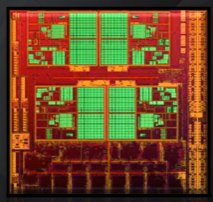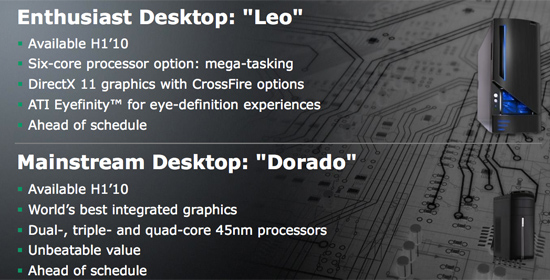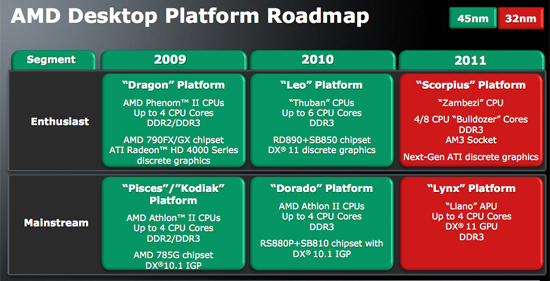It’s got roughly one billion 32nm transistors, fabbed at Globalfoundries. Four CPU cores and a single graphics core. It’s what AMD calls an Accelerated Processing Unit (APU). And we’ll see it in 2011.
Unfortunately that’s a bit late. The APU, codenamed Llano, was originally scheduled for 2010 but got pushed back. In 2009/2010 Intel will be the first to deliver on-chip graphics with Clarkdale/Arrandale, and in late 2010 Sandy Bridge will have on-die graphics.

The first die shot of AMD's 32nm Llano APU based on 32nm Phenom II cores
Above is what I believe to be a die shot of AMD’s first APU. The CPU doesn’t use AMD’s next-generation microarchitecture, that’s only for the server and high end in 2011. The first APU will use the existing Phenom II architecture on the same die as DX11 graphics, but at 32nm. Sandy Bridge will use a brand new microprocessor architecture on 32nm but with updated Intel integrated graphics. It looks like Sandy Bridge will have the CPU advantage while Llano might have the GPU advantage, assuming Intel can't get their GPU act together by then. Llano is on schedule to debut in 2011 with OEM sampling happening before the end of the year.
Also on schedule is AMD’s next-generation microarchitecture, codenamed Bulldozer. AMD listed its client PC goals for 2010 at this year’s Financial Analyst Day, one of them is to start sampling its next-generation microprocessor next year - in 2010. If the chip is ready for OEMs by the end of 2010, that means it’ll go on sale as early as 1H 2011.

Unfortunately AMD isn’t talking much about Bulldozer architecture, I suspect we won’t see that disclosure until mid to late 2010. It’s not to keep things secret, we already have many estimates of what Bulldozer’s architecture is going to look like. And if the public already knows, then Intel is also well aware of what AMD has coming in 2011. Updated: AMD has given a high level overview of its Bulldozer and Bobcat architectures here
A major focus is going to be improving on one of AMD’s biggest weaknesses today: heavily threaded performance. Intel addresses it with Hyper Threading, AMD is throwing a bit more hardware at the problem. The dual integer clusters you may have heard of are the route AMD is taking...

Next year the high end platform will be called Leo. It’s made up of a Thuban CPU, which is an updated Phenom II rev sporting as many as six cores. It’s still 45nm so don’t expect much in the way of new architectural features. Graphics comes courtesy of the Radeon HD 5000 series, which we all know and love. The chipset is going to be AMD’s new 8-series, complete with a new SB850 south bridge.

In 2011 we get Bulldozer and it comes in the form of the Zambezi CPU (AMD’s codenames are such fun). You’ll see four and eight core versions of Zambezi. Both will support DDR3 and both will work in Socket-AM3. Obviously guaranteeing motherboard support this early in the game is difficult, but AMD is usually good about maintaining socket compatibility. You may be able to slip a Zambezi into your current day Socket-AM3 motherboards.
All this plus a chipset and AMD’s 6000-series graphics makes up what’s going to be called the Scorpius platform.
Moving down one notch to mainstream, today we have the Pisces/Kodiak platforms (yep, never heard them called that either). That’s made up of Athlon II CPUs and the 785G chipset with integrated graphics.
Next year we’ll have Dorado, which consists of Athlon II CPUs and next-year’s integrated graphics chipset. Unfortunately it won’t be a DX11 chipset, AMD is only listing 10.1 support in the 2010 platform. Which means that the graphics we’ll see in 2011 integrated on-die will be a derivative of the DX11 Radeon HD 5000 series we have today. Sweet.
The 2011 mainstream desktop platform is called Lynx, purr. It comes with the Llano APU, which as I mentioned before, doesn’t use Bulldozer. Instead Llano is made up of as many as four 32nm Phenom II-like cores. Llano also features an integrated DX11 GPU. Llano will require a new socket as the pinout will have to support video out just like Intel’s Clarkdale.
Source: AnandTech
Unfortunately that’s a bit late. The APU, codenamed Llano, was originally scheduled for 2010 but got pushed back. In 2009/2010 Intel will be the first to deliver on-chip graphics with Clarkdale/Arrandale, and in late 2010 Sandy Bridge will have on-die graphics.

The first die shot of AMD's 32nm Llano APU based on 32nm Phenom II cores
Also on schedule is AMD’s next-generation microarchitecture, codenamed Bulldozer. AMD listed its client PC goals for 2010 at this year’s Financial Analyst Day, one of them is to start sampling its next-generation microprocessor next year - in 2010. If the chip is ready for OEMs by the end of 2010, that means it’ll go on sale as early as 1H 2011.

A major focus is going to be improving on one of AMD’s biggest weaknesses today: heavily threaded performance. Intel addresses it with Hyper Threading, AMD is throwing a bit more hardware at the problem. The dual integer clusters you may have heard of are the route AMD is taking...
AMD's 2010 - 2011 Desktop Roadmap
Today’s high end desktop platform is called Dragon. It’s what you get when you combine a Phenom II, AMD 790FX/GX chipset and a Radeon HD 4000 series graphics card. Nice, but that’s old news now.

All this plus a chipset and AMD’s 6000-series graphics makes up what’s going to be called the Scorpius platform.
Moving down one notch to mainstream, today we have the Pisces/Kodiak platforms (yep, never heard them called that either). That’s made up of Athlon II CPUs and the 785G chipset with integrated graphics.
Next year we’ll have Dorado, which consists of Athlon II CPUs and next-year’s integrated graphics chipset. Unfortunately it won’t be a DX11 chipset, AMD is only listing 10.1 support in the 2010 platform. Which means that the graphics we’ll see in 2011 integrated on-die will be a derivative of the DX11 Radeon HD 5000 series we have today. Sweet.
The 2011 mainstream desktop platform is called Lynx, purr. It comes with the Llano APU, which as I mentioned before, doesn’t use Bulldozer. Instead Llano is made up of as many as four 32nm Phenom II-like cores. Llano also features an integrated DX11 GPU. Llano will require a new socket as the pinout will have to support video out just like Intel’s Clarkdale.
Source: AnandTech




No comments:
Post a Comment